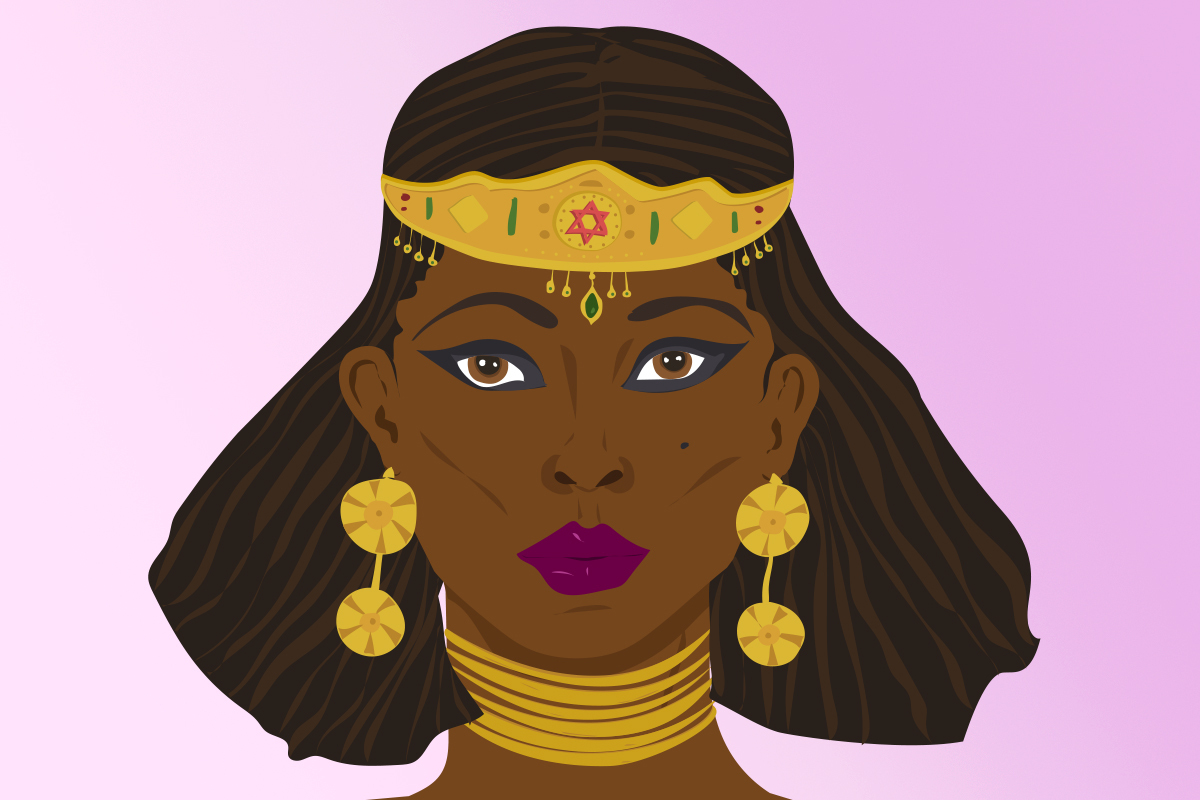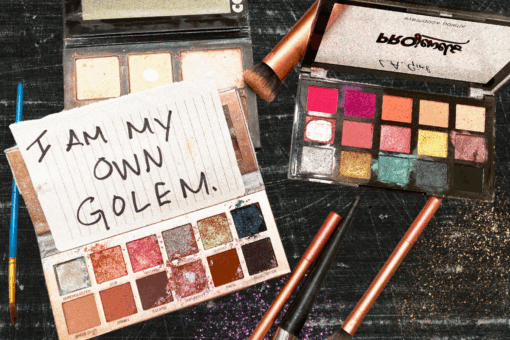Adorned with ornaments of seduction, Lilith, the half-woman-half-demoness of the night, lurks under doorways waiting to seduce men. A salacious figure in Jewish folklore, her story as Adam’s first wife before Eve, banished to a life as a baby-snatching demon for refusing to have missionary sex, was conveniently left out of my Jewish day school education. If she were the only biblical Jewess omitted from my bible lessons, dayenu. But then I discovered my curriculum completely glossed over Asherah, a Canaanite fertility goddess represented by a living tree. And now I’m reckoning with the rotten cherry on top of my ashkenormative upbringing: failure to teach me about the Queen of Sheba, the Black Jewish Queen of the East.
A figure first mentioned in the Book of Kings (I), there are many, many varying stories out there about just who the Queen of Sheba was, and the role that she played in ancient Judaism. Retold with slight variations in Chronicles II, supplemental lore from Targum Sheni, a second elaboration of the Book of Esther, the Legends of the Jews, a fascinating compilation of aggadah (Jewish scripture that doesn’t deal with laws), Alphabet of Ben Sira, an anonymous medieval text, and Antiquities of the Jews, a historical account of the Israelites written by Jewish historian Flavius Josephus, there’s a lot of information out there about the elusive Queen of Sheba.
While Islamic and Christian Ethiopian texts tacked on new stories to retell Sheba’s tale, here’s how the Jewish one, mixed with lore, goes:
Drunk on wine, King Solomon — you know, the super rich and wise king who succeeded his father, King David — was pissed when the Hoopoe bird arrived fashionably late to his impromptu party. Covering his ass, the animal claimed he was searching for a kingdom outside Solomon’s rule and found one in the city of Kitor, controlled by a sun-worshipping woman, AKA the Queen of Sheba. Abundant in silver and gold, the queendom in the east — historians now consider this to be possibly Ethiopia or Egypt — was quenched with water that flowed from the Garden of Eden, and none of its citizens, crowned with garland wreaths from paradise, knew how to fight.
Solomon invites this Queen of Sheba to Jerusalem for a playdate, warning that if she doesn’t come, he’d order demons to “throttle you in your bed at night.” Having heard of Solomon’s God-given gifts — “wisdom and discernment in great measure, with understanding as vast as the sands on the seashore” (Kings I 5:9) — the Black queen agreed, but not because of his threats, but because she wanted to see for herself if the rumors were true. So Sheba strolls into town with every ship in the sea, mounds of gold, and 6,000 men and women of the exact same height born at the same time (what…?). To test the rumor that Sheba had devilish goat legs, Solomon welcomes her in a house of mirrors to trick her into revealing the truth, which she does — while her legs are human, they are just as hairy as the Jewish king’s.
“Thy beauty is the beauty of a woman, but thy hair is masculine; hair is an ornament to a man, but it disfigures a woman,” the Legends of the Jews records Solomon, who apparently has no fucking manners, saying.
Without batting an eye, Sheba asks Solomon a series of riddles about gender and the Torah to test his capacity of wisdom. Found only in apocryphal text, the riddles are assumed to have been omitted from Kings and Chronicles to undermine a female monarch’s power. Ruled by a patriarchal society, Sheba’s chutzpah was fully unheard of, but, as Carole R. Fontaine argues, “extrabiblical records from Egypt and Mesopotamia” support the “presence of strong women rulers of international reputation.” Huzzah!
To Sheba’s delight, the king passes the test, the queen is fully turned on, and, after shaving her legs, they ravage each other. Specifically, on top of what he gifts her out of his “royal bounty” (I Kings 10:13), Solomon gives her “everything she wanted and asked for.” Contemporary scholars (AKA me) argue that under Sheba’s explicit direction, Solomon licked her clit to completion. He also knocked her up — obviously, Trojan hadn’t started their targeted campaign yet.
Now pregnant with their son, Sheba converts to Judaism and marries Solomon. Considering her vast knowledge of Jewish scripture and adoration of the Hebrew God, it’s not such a far leap. Solomon begs his Jewish Black queen to stay in Jerusalem, but Sheba is a woman who compromises for no man, even Solomon the Wise, and refuses to give up her reign in the south and returns to her desert paradise. Their son Nebuchadnezzar eventually became the King of Babylon and destroys his papa’s legacy, Solomon’s Temple. Womp!
In Ethiopia, the Queen of Sheba is hailed as the mother of the land’s first king, and despite being rejected by sages, Jewish culture has absorbed the myth, the legend, the oh-so elusive Black Jewish Queen of the South. Why? As a means to patriarchal dominance, duh! In Kabbalah and the Zohar, Sheba isn’t identified as a queen of a prosperous land, but as Lilith, the queen of demons. Author Eli Yassif explains that Jewish lore on Sheba was written for the sole purpose of proving to Jews that “Solomon, symbol of the kingdom of Israel, had his way with the greatest queen of the east.”
It’s not exactly a legend we should be proud of. Not only did Solomon shtup Sheba, he shamed her into conforming to sexist beauty ideals, supposedly upgrading her from a “demon of the night” to a cultured woman. “It satisfied the need for a sense of triumph, Solomon who uncovered her nakedness, literally of the queen of the desert apparently answered a latent wish hidden deep in the hearts of medieval Jews,” Yassif continues. Vom dot com!
Jewish texts demonize the queen of the desert by rejecting her humanity and characterizing her as a supernatural succubus who knows how to manipulate men with her feminine wiles. Nebuchadnezzar eventually destroys the Jerusalem Temple to avenge his mother, underscoring Sheba’s likeness to Lilith, the baby snatcher, by demonstrating that Sheba gave birth to a “perverse child and for perverse ends.”
And so, the sages took a perfectly lovely story about a biblical Black queen and tore it to shreds with unnecessary stories, transforming her from a majestic embodiment of femininity to that of the evil Nebuchadnezzar’s mother. Sheba might only be featured in the Torah as a tool to highlight Solomon’s sagacity, but like a rug due for a cleaning, it’s not too late to beat the sexism, xenophobia, and racism out of her story.
“Queen of Sheba, in every tradition, is important because of her own wisdom. She knows when to react and when not to. She knows when to ignore advice, that of her council, but also when to embrace it, as she converts. Her questions are specific and pointed, and she knows what to look for to prove Solomon’s divine intelligence,” writes Tamar Kadari, a Midrash scholar.
Drenched in the boring sexist interpretations of Jewish scholars, Sheba’s story can be wrung of misogyny to reveal her true legacy as a Jewish Black biblical babe who got her way with Solomon. Armed with chutzpah and charm, she traveled to Jerusalem, got a divine king to eat out of the palm of her hand (and elsewhere…), and ran a country comparable to the Garden of Eden. See what happens when Black Jewish women are in charge?
Header image design by Grace Yagel.



